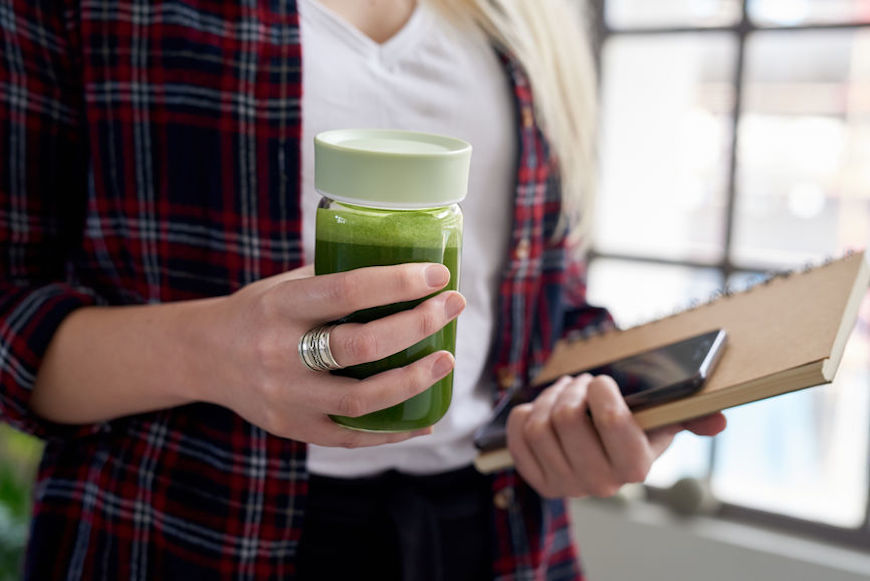
September 07, 2019 at 01:00AM by CWC
I was just a kid when SlimFast meal replacement shakes were popular, but I still remember the commercials. It always involved a svelte looking woman excitedly popping open the can—as if a slice of cake would jump out of it—gulping it down, and leaving a big chocolate milk mustache above her smiling mouth. Back then, I was a big fan of chocolate milk—more of the Nesquik variety—but I still couldn’t understand why someone would want to drink their meal instead of eat it.
Then, I grew up, became a Working Girl myself, and understood the concept (kinda). Sometimes, mornings or afternoons were just so crazy that there didn’t seem to be enough time for a proper sit- down meal. Eating on-the-go was necessary, sometimes, and salads aren’t exactly ideal for that. Only meal replacement shakes weren’t popular anymore; protein bars had replaced them.
It stayed this way for a long while until 2013 when Rob Rhinehart, a young, hungry (both metaphorically and physically) Silicon Valley entrepreneur decided to take meal replacement to the next level with Soylent, a drink that contains all the nutrients someone needs for the day all in one go.
Now, we’ve landed somewhere in the middle of the SlimFast and Soylent mentality: post-protein bar success, food startups like Mēle, Gemini, and Huel, are reinventing the meal replacement shake category with products that have more substance than the ’80s canned options but still left room for eating later in the day. To find out if the meal replacement shakes hitting the market now were truly good options in lieu of solid food, I talked to a dietitian and the companies themselves.
The rules when replacing a meal with anything—shake or otherwise
ADVERTISEMENT
ADVERTISEMENTKate Spade Autumn/Winter Sale |
When I asked registered dietitian and Eighty-20 Nutrition president Christy Brissette, RD about the rise of meal replacement shakes, she told me that they tend to be pretty on par with protein bars: fine in a pinch or for some fast fuel, but not typically great to live off of day in and day out. “In general, they’re pretty similar, so if you’re not a bar person, a shake could be a good way to go instead,” she says.
“It’s always going to be better to get your nutrients from unprocessed, whole foods,” she adds. In general, she says a good meal has between 20 and 30 grams of protein, at least ten grams of fiber, healthy fats, and enough calories that will leave you feeling sustained. So when considering a meal replacement shake, check out the nutritional panel, and as always, the ingredients. Brissette also says they might not be the best way to go if someone has a history with disordered eating; the intention behind why you’re reaching for a shake instead of a plate of food matters.
But with all this in mind, she is interested to see how meal replacement shakes have evolved since the ’80s chocolate milk mustache days…
The new crop of meal replacement shakes
Mēle CEO Elise Tresley says she founded her company because even with so many smoothie and juice bars, she had trouble finding an option that was non-GMO, soy-free, preservative-free, and didn’t have added sugar. “Because Mēle is low-glycemic, it breaks down slowly and trickles glucose into your system over time, reducing fluctuations in blood sugar and leading to sustained energy,” she says. Tresley and her team formulated two types of shakes, plant-based (made with brown rice protein and pea protein) and whey-based, also including various fruits, nuts, and flaxseed (all in powder form). Together, you get 18 grams of protein, six grams of fiber, and 7 grams of healthy fats.
Brissette says the protein content makes Mēle a good option for a post-workout recovery snack or to get through a mid-morning or late afternoon slump, but because the calories are only 250 a shake, she isn’t fully convinced it works as a meal replacement. “As far as a meal goes, the calories, protein, and fiber are all a bit low, but the seven grams of fats is at least going to make it satiating and help you feel full,” she says. “Ideally for a meal, the protein should be higher, between 20 to 30 grams, and the calories should definitely be higher.”
One new meal replacement shake Brissette was into is Huel, though the company’s CEO James McMaster does not refer to the products—which include three different ready-to-drink blends and a ready-to-blend powder—as shakes. “Huel is food and provides a nutritionally complete meal providing all essential vitamins and minerals,” he says. “It’s made from six main food ingredients; oats, brown rice, pea, flaxseed, sunflower seeds, and coconut, and fortified with a vitamin and mineral blend of all the 27 essential vitamins and minerals, to give your body all the precious micronutrients it needs.”
“This is kind of like taking a multivitamin with your protein shake,” Brissette says of Huel. While she says the nutrition panel checks the boxes required to sub in for a traditional meal (400 calories, 20 grams of protein, 6 grams of fiber, and 19 grams of healthy fats), she (not surprisingly) recommends it more as a sometimes stand-in and not used daily. “This is a good option for when you really don’t have time to prepare or eat a plated meal, but I wouldn’t recommend it for all-the-time use,” she says.
Her reasoning is in-line with McMaster’s: “Realistically, it’s not always possible to get access to a nutritious meal when you’re running out the door, on the road or at work,” he says. “Huel is there to prevent poor meal options when time is limited,” he says. “A lot of convenience food is low in nutritional value and lacking in plant-based meal options.”
While Mēle aims to be whole foods in shake form and Huel is essentially half-supplement, Gemini—a meal replacement shake by Unico Nutrition—is more of a true meal replacement, plus all the fancy extras you’ve added to your wellness routine. It starts off like a standard vegan protein powder (eight grams per serving, sourced from pea, hemp, and quinoa proteins) but then includes other buzzy wellness ingredients like MCT oil, fiber from sweet potato, spinach, cassava flour, steal cut oats, and flaxseed, a probiotic blend, prebiotic inulin, digestive enzymes, and even ashwagandha.
Brand founder Lance Herrington says the idea of what a meal is has changed, so products should too. That’s why they crafted their blend to prioritize macronutrient needs as well as gut health. “This is a dramatic departure from the traditional, cost-effective approach to the ‘meal replacement’ product, which typically consists of a dairy-based protein fortified with synthetic vitamins and empty carbohydrate. We believe our Gemini to be a much more effective fuel for the human body and mind,” he says.
“It’s very flashy and trendy in terms of the ingredients,” Brissette says. “I also like that they are sourcing from a lot of different phytonutrients and real foods, not isolated vitamins or nutrients.” Still, she raises a skeptical eye at some of the extras, like the probiotic blend and the digestive enzymes. “There is not sufficient evidence to show everyone should be taking digestive enzymes,” she says. “And I’d want more research into the specific probiotic blend they’re using.” The takeaway here is that people’s wellness needs tend to be pretty individual—and it can be hard to encapsulate something that works for everyone in one powder. Not everyone should take the same probiotic, for example. “I do like it, but I like it for someone to have as just part of a meal or as a small snack,” she concludes.
Even though she has her criticisms, Brissette is overall encouraged by how the meal replacement shake category continues to evolve. “A meal replacement shake can be a great option for those times when you’re stuck in meetings all day or need to eat while commuting to work,” she says. “But it’s still not the same as a plate of food. Real, whole food is always going to be better.”
ADVERTISEMENT
ADVERTISEMENTSports Direct Free Delivery on All Orders! |
Something else that’s gotten an upgrade: ramen. High-fiber products are also trending. Here’s the verdict on if they’re worth adding to your grocery cart.
Author Emily Laurence | Well and Good
Selected by CWC
ADVERTISEMENT
ADVERTISEMENTUp to 30% off Gift Sets |







